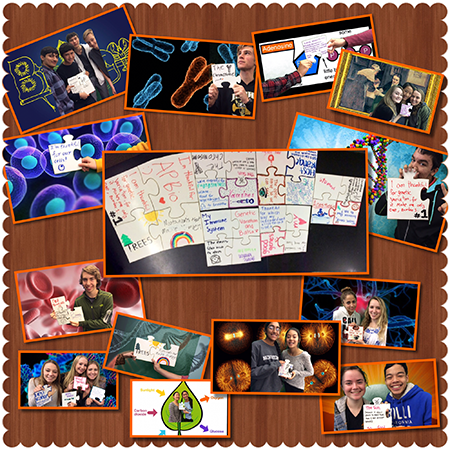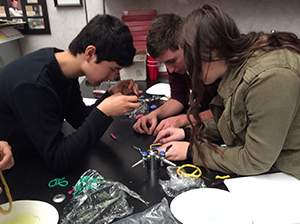A Tale of Technology and Thanksgiving
Author: Anna Babarinde
Published: 11.23.15
 I will be the first to admit that while I’m a huge advocate for its importance in education, I am not the most technologically savvy person. I want to be, but it doesn’t come naturally to me, and this along with structural challenges gives me angst when I bring technological opportunities into the classroom. However, this week as we all looked forward to (or in some cases desperately longed for and clawed our way towards) Thanksgiving break, I took the plunge and engaged my AP Biology students in two opportunities to learn and reflect on content while building technology skills.
I will be the first to admit that while I’m a huge advocate for its importance in education, I am not the most technologically savvy person. I want to be, but it doesn’t come naturally to me, and this along with structural challenges gives me angst when I bring technological opportunities into the classroom. However, this week as we all looked forward to (or in some cases desperately longed for and clawed our way towards) Thanksgiving break, I took the plunge and engaged my AP Biology students in two opportunities to learn and reflect on content while building technology skills.
The first activity was a modeling assignment based around the cell cycle. Students created clay models and then used Lego Movie Maker to make and narrate stop motion films addressing questions about cell cycles and genetic variation. The second project was developing “science thanksgivings”- a welcome activity in light of the upcoming holiday and the fact that students had just taken a test. Students took a few minutes to brainstorm things they’re particularly thankful for that relate to biology. They then wrote these on whiteboard puzzle pieces (courtesy of Casey Shea at SCOE) and practiced taking pictures in front of a green screen and superimposing backgrounds that related to their thanksgivings. We later put puzzle pieces together to create a larger visual of how much there is to be thankful for in science.
I created these activities to help students develop skills for an upcoming semester film project, but I was struck by how worthwhile they were even as stand-alone experiences. The activities were highly engaging for students and incredibly valuable for me as the teacher. As I worked with groups on their modeling activity and later viewed the videos, I could see immediately the collaboration and creativity required but also what concepts students understood and where they needed more support. Developing science thanksgivings gave students an opportunity to reflect on and discuss what they’d learned so far this year and how it relates to the world and their lives. The project was also inspirational for me and them on a human level. Both days students left with smiles, commenting on how much fun the work was and thanking me for the opportunities. And I left thankful for a great many things related to these experiences.
I’m incredibly thankful for the technology resources available to me and students. In September I had the chance to take some students on a field trip to Medtronic where the staff did a great job of introducing students to opportunities in STEM careers through relatable speakers, hands-on activities, and tours of labs and workspaces. The students left excited about the possibilities out there and with a strong desire to ask for 3D printers for Christmas. I left strongly convicted that students need more exposure to and experience with technology and how to meaningfully incorporate it into tasks in order to make them competitive in the job market and world.
It’s only in the last month that we’ve gotten reliable wi-fi at my school and received laptops to replace the nine-year-old teacher desktops. We don’t have devices for every student, but there are options available such as checking out a Chromebook cart from the school or requesting to borrow iPads from SCOE. All of these resources mark the removal of a significant barrier to incorporating technology in the classroom, and I am grateful for the opportunities that are opening up as a result.
I’m also very thankful for innovative, dynamic colleagues who care deeply about students developing creative and critical thinking skills, perseverance, and digital literacy. Incorporating technology adds a layer of time and coordination both in and out of the classroom. I need to learn how to use and trouble-shoot the technology myself and craft lessons that include technology in a meaningful way. Introducing a technological component also requires a new level of risk and vulnerability on the part of the teacher and the students. It’s not business as usual, and there’s more chances for things to go wrong and for questions to arise that I don’t know the answer to. All of these factors can seem daunting, and I’m thankful that there are educators at SCOE such as Matt O’Donnell, 21st Century Technology Innovation Specialist, and Casey Shea, Teacher-on-Loan for Make, who can articulate why these tools and experiences are so valuable for students and support teachers in learning and taking risks. Working alongside them, learning from them, and seeing that pushing the envelope is worth it even when sometimes your efforts literally go up in flames makes me to be a better educator. I’m very grateful to know them and all my colleagues and witness the passion they bring to supporting and changing education.
Finally, I’m more thankful than words can express for students who are willing to be flexible and take a chance on new things. Their desire to learn, excitement at new discoveries, and ability to put themselves out there and take risks inspires me every day. I was reminded again as we engaged in the modeling and thanksgivings this week that I have many students who will jump in, fully embrace new experiences, and articulately describe what they got out of them. They are deep thinkers, a lot of fun, and have the ability to one day change the world. Spending time with them and being part of their learning and development is a great privilege that I don’t want to take for granted.

I don’t make light of the challenges and barriers surrounding bringing technology into the classroom in a meaningful way. I know from observations in classrooms and conversations with teachers and administrators around the state that the challenges I’ve mentioned are not unique to me—they’re endemic in education right now. The easiest thing to do when faced with these challenges would be to ignore technology and continue with business as usual. But that is a disservice to students who desperately need experiences to prepare them for college and career. Some of them have a good deal of technology savvy from their lives outside of school. But others don’t have access to technology or ways to build their skill apart from classroom experiences. And none of them have enough practice integrating technology meaningfully into their learning and work. So, for better or worse, they are relying on us. As we live more and more in a world where STEM careers, industries, and topics intersect with students’ lives and our own, we need to look very carefully at our response and what it means for them and the world.
Thanksgiving may seem a strange time to think about technology in school. We’re all exhausted and in much need of a break after the long stretch from August to November. This doesn’t seem like the time to add another layer to the classroom or take on a new challenge. And yet, Thanksgiving offers a time to stop and be thankful for what is and what’s possible. So there is no better time to take stock of what opportunities we can embrace and look expectantly to see what change that might bring. As J. Robert Moskin so eloquently put it, “Thanksgiving comes to us out of the prehistoric dimness, universal to all ages. At whatever straws we must grasp, there is always a time for gratitude and new beginnings.” May this holiday provide you the break to reflect on what you’re thankful for and to prepare for new beginnings as the world changes and we seek to shape some of that change in science education.
Blog: Exploring NGSS

